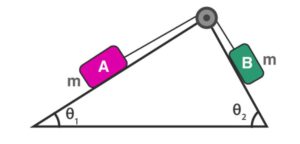In the figure, a body A of mass m slides on a plane inclined at angle θ1 to the horizontal and μ1 is the coefficient of friction between A and the plane. A is connected by a light string passing over a frictionless pulley to another body B, also of mass m, sliding on a frictionless plane inclined at angle θ2 to the horizontal. Which of the following statements are true?;a) A will never move up the plane b) A will just start moving up the plane when

c) for A to move up the plane, θ2 must always be greater than θ1 d) B will always slide down with constant speed

![]()

![]()